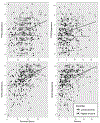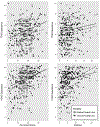Income as a moderator of psychological stress and nicotine dependence among adult smokers
- PMID: 29729584
- PMCID: PMC6205698
- DOI: 10.1016/j.addbeh.2018.04.021
Income as a moderator of psychological stress and nicotine dependence among adult smokers
Abstract
Background: Perceived stress and psychological distress are associated with more cigarette craving and withdrawal, higher nicotine dependence, and less success during quit attempts. Low income smokers have disproportionately higher rates of smoking and may be particularly vulnerable to the effects of stress on smoking dependence. The aim of the current study was to assess if lower income smokers have a stronger association between stress and nicotine dependence than higher income smokers.
Methods: Data were obtained from the Pennsylvania Adult Smoking Study, which included 351 daily smokers. Subjects completed PhenX Toolkit and other self-report measures of socioeconomic factors, the 10-item Perceived Stress Scale, Kessler Psychological Distress Scale (K6), Fagerstrom Test for Nicotine Dependence (FTND), and the Hooked on Nicotine Checklist (HONC). Moderation analyses using linear regression examined income-related differences in the association between stress and nicotine dependence.
Results: Income groups were categorized by an annual household income of $50,000 based on visual-inspection of scatter plots of income by nicotine dependence. Compared to higher income smokers, lower income smokers had significantly higher mean levels of nicotine dependence on the FTND [3.74 vs. 4.79, p < 0.001], perceived stress [15.63 vs. 17.95, p = 0.004], and psychological distress [5.30 vs. 6.86, p = 0.001], respectively. There were interaction effects, such that lower income smokers had a strong, positive associations between FTND and perceived stress (B = -0.11, CI = -0.17 to -0.04, p = 0.002) and psychological distress (B = -0.13, CI = -0.25 to -0.02, p = 0.022) whereas no association was found in higher income smokers. No significant moderation effects were found for the HONC or when income groups were categorized by U.S. federal poverty level.
Conclusions: The results highlight that the relationship between increasing stress and FTND was found in lower but not higher income groups. Future research should examine socioeconomic, environmental and psychosocial factors that may facilitate increased smoking during stress-induced craving.
Keywords: Dependence; Distress; Income; Nicotine; Socioeconomic; Stress.
Copyright © 2018 Elsevier Ltd. All rights reserved.
Conflict of interest statement
Conflict of interest:
None declared.
Figures



References
-
- Cohen S, Kamarck T, Mermelstein R. A global measure of perceived stress. J Health Soc Behav. 1983;24(4):385–96. - PubMed
Publication types
MeSH terms
Grants and funding
LinkOut - more resources
Full Text Sources
Other Literature Sources
Medical

